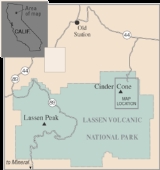
Cinder Cone and the Fantastic Lava Beds
Encyclopedia
Cinder Cone is a cinder cone
volcano
in Lassen Volcanic National Park
(itself in Northern California
in the United States
). Within the park it is located about 10 miles (16.1 km) northeast of Lassen Peak
and provides an excellent view of Brokeoff Mountain, Lassen Peak, and Chaos Crags
.
The cone was built to a height of 750 feet (228.6 m) above the surrounding area and spread ash
over 30 square miles (77.7 km²). Then, like many cinder cones, it was snuffed out when several basalt
lava
flows erupted from its base. These flows, called the Fantastic Lava Beds, spread northeast and southwest, and dammed creeks, first creating Snag Lake on the south and then Butte Lake
to the north. Butte Lake is fed by water from Snag Lake seeping through the lava beds. Nobles Emigrant Trail
goes around Snag Lake and follows the edge of the lava beds.
Its age has been controversial since the 1870s, when many people thought it was only a few decades old. Later, the cone and associated lava flows were thought to have formed about 1700 or during a 300-year- long series of eruptions
ending in 1851. However, recent studies by U.S. Geological Survey (USGS) scientists, working in cooperation with the National Park Service
to better understand volcano hazards in the Lassen area, have firmly established that Cinder Cone was formed during two eruptions that occurred in the 1650s.
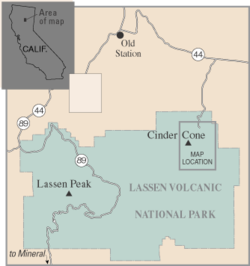
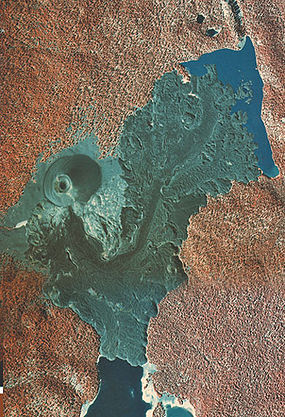
 Cinder Cone is a 700 ft (213 m) high cone of loose scoria
Cinder Cone is a 700 ft (213 m) high cone of loose scoria
. Scoria forms when blobs of gas-charged lava are thrown into the air during an eruption and cool in flight, falling as dark volcanic rock
containing cavities created by trapped gas
bubbles. The summit of Cinder Cone has a crater
with a double rim (photo), probably created by fluctuating eruptive activity late in its formation. The cone also has several associated blocky lava
flows, and a related, widespread ash
deposit identifiable for 8 to 10 mi (12.9 to 16.1 km) from the cone. There are actually two scoria cones at Cinder Cone—the remnants of a nearly completely buried earlier cone can be seen on the larger cone's south side. Much of the earlier cone was probably destroyed by lava flows erupting from its base. Blocks of red, cemented scoria within the Painted Dunes lava flows (photo) are pieces of this earlier cone, which were carried away by the flowing lava.
During its formation, the composition of the molten rock (magma
) feeding the eruption changed from basaltic andesite
to andesite and then back to basaltic andesite, but with a higher titanium
content. Chemically, basaltic andesites are volcanic rocks containing 53 to 57% silica (Si
O
2), and andesites are those containing 57 to 63% silica. Though chemically distinct, the lava flows and scorias at Cinder Cone are similar in appearance. They are dark, fine-grained rocks, containing a few visible crystals of the minerals olivine
, plagioclase
, and quartz
.
The earlier erupted group of volcanic deposits at Cinder Cone, which are relatively titanium-poor, consist of the older scoria cone, the Old Bench flow, the two Painted Dunes flows, and the lower part of the widespread ash layer. The later erupted, relatively titanium-rich group consists of the large, younger scoria cone, the upper part of the ash layer, and the two Fantastic Lava Beds flows. Flow 2 of the Fantastic Lava Beds (see geologic map) is the flow that everyone but Diller thought had been erupted in 1851. The ash on the Old Bench and Painted Dunes lava flows is brightly oxidized because it fell on the lava flows when they were still hot. This oxidized ash belongs to the same compositional group as the Fantastic Lava Beds flows, the last flows erupted at Cinder Cone. All the volcanic materials at Cinder Cone therefore represent a single eruptive sequence that probably spanned no more than a few months.
An unusual characteristic of the Fantastic Lava Beds is the presence of anomalous quartz
crystal xenocrysts
(foreign bodies in igneous rock
). Geologists think that they were picked up from wall rocks by the lava as it moved toward the surface. The lava and pyroclastics
of Cinder Cone and the Fantastic Lava Beds are made of basaltic andesite to andesite
.
reported seeing an erupting volcano that “threw up fire to a terrible height.” They further claimed that they walked 10 miles over rocks so hot that their boots were entirely destroyed.
In the early 1870s, H. W. Harkness
, a medical doctor and observant amateur scientist from San Francisco, California
, visited and described the Cinder Cone area. He was impressed by the apparent youthfulness of the volcanic features, and described a number of lines of evidence that he interpreted to mean that Cinder Cone was only about 25 years old.
After presenting his findings at a meeting of the California Academy of Sciences
, Harkness was contacted by Henry Chapman, an Academy member, who told him of hearing the gold prospectors tell their story. He was also contacted by several others who claimed to have witnessed a volcanic eruption in the Lassen area around 1851, including a Dr. O.M. Wozencraft
. Harkness thought that all these tales of volcanic activity might be related to an eruption of Cinder Cone.
The circumstances surrounding these reports are somewhat obscure and inconsistent. Several reports of “volcanic eruptions” in the Lassen area had appeared in Northern California newspapers in the 1850s, but Harkness was probably unaware of them. In the earliest of these, published in the August 21, 1850, edition of the Daily Pacific News, a San Francisco newspaper, an unnamed observer reported seeing an erupting volcano with “burning lava still running down the sides.” In 1859, the San Francisco Times printed an article in which Dr. Wozencraft and a companion were purported to have seen, from a position somewhere west of the Lassen area, flames in the sky that they attributed to a volcanic eruption. This article was widely reprinted and popularized in other papers, but no specific date or location was given for their sighting. The Shasta Republican noted on several occasions in April 1859 that “the Dr.’s imagination is far more active than any volcano in our County or State.” It was in Harkness’ 1875 report that the date of Wozencraft’s observation is first mentioned to be the winter of 1850–1851.
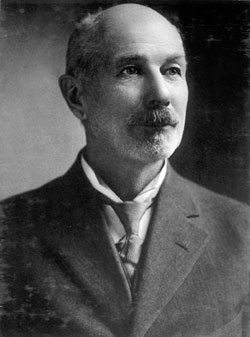 The first geologist to study Cinder Cone was Joseph Diller, who was among the first USGS scientists to study volcanoes. Diller made careful observations of Cinder Cone and interviewed many Native Americans
The first geologist to study Cinder Cone was Joseph Diller, who was among the first USGS scientists to study volcanoes. Diller made careful observations of Cinder Cone and interviewed many Native Americans
and European trappers and settlers who were in the Lassen region in 1850. None of them could recall witnessing any volcanic activity in the area. Diller knew that an “emigrant road” (the Nobles Trail), used by settlers coming to California in the early 1850s, passes close to the base of Cinder Cone. He spoke with several people who had “crossed the trail” in 1853. They noted that a large, solitary willow bush (Salix scouleriana
) near the summit of Cinder Cone was “as large then as now.” Today, more than a century after Diller’s interviews, this bush is still alive and little changed.
Because the “Scouler willow” at the summit of Cinder Cone was already mature in 1853, Diller concluded it was extremely unlikely that an eruption could have occurred there in the winter of 1850. He also noted that tree
s rooted in volcanic ash erupted from the cone were about 200 years old and that the oldest trees on related lava flows were about 150 years old. Diller believed he recognized two eruptive sequences, which each produced lava flows. However, he thought that only the older eruption was explosive, creating Cinder Cone and the ash deposits. In regard to the explosive eruption, he concluded that “Whatever may be the historical testimony as to the time of the eruption, the geologic evidence clearly demonstrates that it must have occurred long before the beginning of the present century” (before 1800). Diller therefore speculated that the explosive eruption had occurred between about 1675 and 1700 and that the younger, quiet eruption was “certainly” sometime before 1840.
In the mid-1930s, USGS volcanologist R.H. Finch attempted to improve on Diller’s work. On the basis of other studies done at Cinder Cone, Finch thought (1) that there had been at least five separate lava-flow events, as suggested by crude, experimental magnetic measurements; (2) that the youngest lava flow was extruded in 1851, accepting Harkness’ (1875) historical “evidence” and ignoring Diller’s interviews and conclusions; and (3) that there had been at least two distinct explosive eruptions of the cone. Using these assumptions and tree-ring measurements, Finch proposed a complex and detailed eruptive chronology for Cinder Cone that spanned nearly 300 years. From measurements of the rings of one particular tree, which showed two periods of slow growth, he thought that the two explosive eruptions occurred in 1567 and 1666. He also concluded that the five lava flows were extruded in 1567, 1666, 1720, 1785, and 1851.
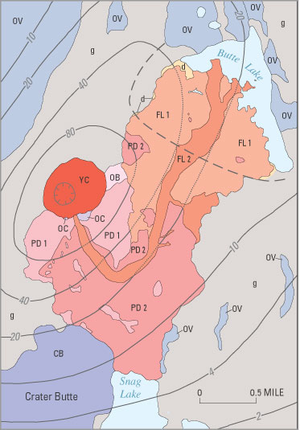
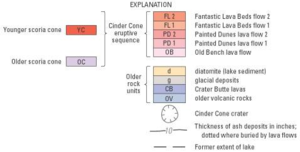 After Finch published his work in 1937, few additional studies were done on volcano hazards in the Lassen area. However, that changed after the 1980 eruption of Mount St. Helens
After Finch published his work in 1937, few additional studies were done on volcano hazards in the Lassen area. However, that changed after the 1980 eruption of Mount St. Helens
in Washington. As a result, the USGS began reevaluating the risks posed by other potentially active volcanoes in the Cascade Range, including those in Lassen Volcanic National Park. Since that time, USGS scientists have been working in cooperation with the National Park Service to better understand volcano hazards in the Lassen area. As part of this work, the history of Cinder Cone has been reexamined. Most of the features of Cinder Cone have changed little since Harkness first described them in the 1870s, but all of the assumptions on which Finch based his conclusions have now been shown to be incorrect.
Through new field and laboratory work and by reinterpreting data from previous studies, USGS scientists have shown that the entire eruptive sequence at Cinder Cone represents a single continuous event. Because the orientation of the Earth’s magnetic field in northern California during the 1850s is well known and is different from the remnant magnetizations at Cinder Cone, the lava flows there could not have been erupted in 1850 or 1851. Also, there are no discernible differences in the magnetic orientation recorded by any of the Cinder Cone lava flows, and so the flows had to be extruded during an interval of less than 50 years.
Although paleomagnetic evidence can be used to rule out the 1850s as the age of Cinder Cone, it does not provide an actual age for its eruption. By measuring levels of carbon-14 in samples of wood from trees killed by the eruption of Cinder Cone, USGS scientists obtained a radiocarbon date for the eruption of between 1630 and 1670. Such a date is also consistent with the remnant magnetization preserved in the lava flows. The series of eruptions that produced the volcanic deposits at Cinder Cone were complex and are by no means completely understood. However, the new studies done by USGS scientists refute the purported accounts of an eruption in the early 1850s and confirm Diller’s (1891, 1893) interpretation that Cinder Cone erupted in the latter half of the 17th century. They also suggest that the 1666 tree-ring date proposed by Finch (1937) for his “second” explosive eruption at Cinder Cone might actually date the entire eruptive sequence.
Cinder cone
According to the , Cinder Cone is the proper name of 1 cinder cone in Canada and 7 cinder cones in the United States:In Canada: Cinder Cone In the United States:...
volcano
Volcano
2. Bedrock3. Conduit 4. Base5. Sill6. Dike7. Layers of ash emitted by the volcano8. Flank| 9. Layers of lava emitted by the volcano10. Throat11. Parasitic cone12. Lava flow13. Vent14. Crater15...
in Lassen Volcanic National Park
Lassen Volcanic National Park
Lassen Volcanic National Park is a United States National Park in northeastern California. The dominant feature of the park is Lassen Peak; the largest plug dome volcano in the world and the southern-most volcano in the Cascade Range...
(itself in Northern California
Northern California
Northern California is the northern portion of the U.S. state of California. The San Francisco Bay Area , and Sacramento as well as its metropolitan area are the main population centers...
in the United States
United States
The United States of America is a federal constitutional republic comprising fifty states and a federal district...
). Within the park it is located about 10 miles (16.1 km) northeast of Lassen Peak
Lassen Peak
Lassen Peak is the southernmost active volcano in the Cascade Range. It is part of the Cascade Volcanic Arc which is an arc that stretches from northern California to southwestern British Columbia...
and provides an excellent view of Brokeoff Mountain, Lassen Peak, and Chaos Crags
Chaos Crags
Chaos Crags is the youngest group of lava domes in Lassen Volcanic National Park, California, having been formed as five dacite domes 1,100-1,000 years ago...
.
The cone was built to a height of 750 feet (228.6 m) above the surrounding area and spread ash
Volcanic ash
Volcanic ash consists of small tephra, which are bits of pulverized rock and glass created by volcanic eruptions, less than in diameter. There are three mechanisms of volcanic ash formation: gas release under decompression causing magmatic eruptions; thermal contraction from chilling on contact...
over 30 square miles (77.7 km²). Then, like many cinder cones, it was snuffed out when several basalt
Basalt
Basalt is a common extrusive volcanic rock. It is usually grey to black and fine-grained due to rapid cooling of lava at the surface of a planet. It may be porphyritic containing larger crystals in a fine matrix, or vesicular, or frothy scoria. Unweathered basalt is black or grey...
lava
Lava
Lava refers both to molten rock expelled by a volcano during an eruption and the resulting rock after solidification and cooling. This molten rock is formed in the interior of some planets, including Earth, and some of their satellites. When first erupted from a volcanic vent, lava is a liquid at...
flows erupted from its base. These flows, called the Fantastic Lava Beds, spread northeast and southwest, and dammed creeks, first creating Snag Lake on the south and then Butte Lake
Butte Lake (California)
Butte Lake is a lake located in the northeast section of Lassen Volcanic National Park at an elevation of .-Description:The irregularly-shaped lake lies at the northern end of Cinder Cone and the Fantastic Lava Beds, which is a complex of lava flows and a cinder cone.The lake also contains a vast...
to the north. Butte Lake is fed by water from Snag Lake seeping through the lava beds. Nobles Emigrant Trail
Nobles Emigrant Trail
The Nobles Emigrant Trail, also known as the Fort Kearney, South Pass and Honey Lake Wagon Road, is a trail in California that was used by emigrant parties from the east as a shortened route to northern California. It was pioneered in 1851 by William Nobes, who discovered an easy shortcut between...
goes around Snag Lake and follows the edge of the lava beds.
Its age has been controversial since the 1870s, when many people thought it was only a few decades old. Later, the cone and associated lava flows were thought to have formed about 1700 or during a 300-year- long series of eruptions
Volcanic Eruptions
Volcanic Eruptions is a company owned by Crispin Glover. The company produces and issues Glover's work: It has released two films to date, What Is It? and its sequel, It is Fine! EVERYTHING IS FINE . Its current plans include releasing the final film in the trilogy titled It Is Mine...
ending in 1851. However, recent studies by U.S. Geological Survey (USGS) scientists, working in cooperation with the National Park Service
National Park Service
The National Park Service is the U.S. federal agency that manages all national parks, many national monuments, and other conservation and historical properties with various title designations...
to better understand volcano hazards in the Lassen area, have firmly established that Cinder Cone was formed during two eruptions that occurred in the 1650s.
Description



Scoria
Scoria is a volcanic rock containing many holes or vesicles. It is most generally dark in color , and basaltic or andesitic in composition. Scoria is relatively low in mass as a result of its numerous macroscopic ellipsoidal vesicles, but in contrast to pumice, all scoria has a specific gravity...
. Scoria forms when blobs of gas-charged lava are thrown into the air during an eruption and cool in flight, falling as dark volcanic rock
Volcanic rock
Volcanic rock is a rock formed from magma erupted from a volcano. In other words, it is an igneous rock of volcanic origin...
containing cavities created by trapped gas
Gas
Gas is one of the three classical states of matter . Near absolute zero, a substance exists as a solid. As heat is added to this substance it melts into a liquid at its melting point , boils into a gas at its boiling point, and if heated high enough would enter a plasma state in which the electrons...
bubbles. The summit of Cinder Cone has a crater
Volcanic crater
A volcanic crater is a circular depression in the ground caused by volcanic activity. It is typically a basin, circular in form within which occurs a vent from which magma erupts as gases, lava, and ejecta. A crater can be of large dimensions, and sometimes of great depth...
with a double rim (photo), probably created by fluctuating eruptive activity late in its formation. The cone also has several associated blocky lava
Lava
Lava refers both to molten rock expelled by a volcano during an eruption and the resulting rock after solidification and cooling. This molten rock is formed in the interior of some planets, including Earth, and some of their satellites. When first erupted from a volcanic vent, lava is a liquid at...
flows, and a related, widespread ash
Volcanic ash
Volcanic ash consists of small tephra, which are bits of pulverized rock and glass created by volcanic eruptions, less than in diameter. There are three mechanisms of volcanic ash formation: gas release under decompression causing magmatic eruptions; thermal contraction from chilling on contact...
deposit identifiable for 8 to 10 mi (12.9 to 16.1 km) from the cone. There are actually two scoria cones at Cinder Cone—the remnants of a nearly completely buried earlier cone can be seen on the larger cone's south side. Much of the earlier cone was probably destroyed by lava flows erupting from its base. Blocks of red, cemented scoria within the Painted Dunes lava flows (photo) are pieces of this earlier cone, which were carried away by the flowing lava.
During its formation, the composition of the molten rock (magma
Magma
Magma is a mixture of molten rock, volatiles and solids that is found beneath the surface of the Earth, and is expected to exist on other terrestrial planets. Besides molten rock, magma may also contain suspended crystals and dissolved gas and sometimes also gas bubbles. Magma often collects in...
) feeding the eruption changed from basaltic andesite
Basaltic andesite
Basaltic andesite is a black volcanic rock containing about 55% silica. Minerals in basaltic andesite include olivine, augite and plagioclase. Basaltic andesite can be found in volcanoes around the world, including in Central America and the Andes of South America. Basaltic andesite is common in...
to andesite and then back to basaltic andesite, but with a higher titanium
Titanium
Titanium is a chemical element with the symbol Ti and atomic number 22. It has a low density and is a strong, lustrous, corrosion-resistant transition metal with a silver color....
content. Chemically, basaltic andesites are volcanic rocks containing 53 to 57% silica (Si
Silicon
Silicon is a chemical element with the symbol Si and atomic number 14. A tetravalent metalloid, it is less reactive than its chemical analog carbon, the nonmetal directly above it in the periodic table, but more reactive than germanium, the metalloid directly below it in the table...
O
Oxygen
Oxygen is the element with atomic number 8 and represented by the symbol O. Its name derives from the Greek roots ὀξύς and -γενής , because at the time of naming, it was mistakenly thought that all acids required oxygen in their composition...
2), and andesites are those containing 57 to 63% silica. Though chemically distinct, the lava flows and scorias at Cinder Cone are similar in appearance. They are dark, fine-grained rocks, containing a few visible crystals of the minerals olivine
Olivine
The mineral olivine is a magnesium iron silicate with the formula 2SiO4. It is a common mineral in the Earth's subsurface but weathers quickly on the surface....
, plagioclase
Plagioclase
Plagioclase is an important series of tectosilicate minerals within the feldspar family. Rather than referring to a particular mineral with a specific chemical composition, plagioclase is a solid solution series, more properly known as the plagioclase feldspar series...
, and quartz
Quartz
Quartz is the second-most-abundant mineral in the Earth's continental crust, after feldspar. It is made up of a continuous framework of SiO4 silicon–oxygen tetrahedra, with each oxygen being shared between two tetrahedra, giving an overall formula SiO2. There are many different varieties of quartz,...
.
The earlier erupted group of volcanic deposits at Cinder Cone, which are relatively titanium-poor, consist of the older scoria cone, the Old Bench flow, the two Painted Dunes flows, and the lower part of the widespread ash layer. The later erupted, relatively titanium-rich group consists of the large, younger scoria cone, the upper part of the ash layer, and the two Fantastic Lava Beds flows. Flow 2 of the Fantastic Lava Beds (see geologic map) is the flow that everyone but Diller thought had been erupted in 1851. The ash on the Old Bench and Painted Dunes lava flows is brightly oxidized because it fell on the lava flows when they were still hot. This oxidized ash belongs to the same compositional group as the Fantastic Lava Beds flows, the last flows erupted at Cinder Cone. All the volcanic materials at Cinder Cone therefore represent a single eruptive sequence that probably spanned no more than a few months.
An unusual characteristic of the Fantastic Lava Beds is the presence of anomalous quartz
Quartz
Quartz is the second-most-abundant mineral in the Earth's continental crust, after feldspar. It is made up of a continuous framework of SiO4 silicon–oxygen tetrahedra, with each oxygen being shared between two tetrahedra, giving an overall formula SiO2. There are many different varieties of quartz,...
crystal xenocrysts
Xenolith
A xenolith is a rock fragment which becomes enveloped in a larger rock during the latter's development and hardening. In geology, the term xenolith is almost exclusively used to describe inclusions in igneous rock during magma emplacement and eruption...
(foreign bodies in igneous rock
Igneous rock
Igneous rock is one of the three main rock types, the others being sedimentary and metamorphic rock. Igneous rock is formed through the cooling and solidification of magma or lava...
). Geologists think that they were picked up from wall rocks by the lava as it moved toward the surface. The lava and pyroclastics
Pyroclastic rock
Pyroclastic rocks or pyroclastics are clastic rocks composed solely or primarily of volcanic materials. Where the volcanic material has been transported and reworked through mechanical action, such as by wind or water, these rocks are termed volcaniclastic...
of Cinder Cone and the Fantastic Lava Beds are made of basaltic andesite to andesite
Andesite
Andesite is an extrusive igneous, volcanic rock, of intermediate composition, with aphanitic to porphyritic texture. In a general sense, it is the intermediate type between basalt and dacite. The mineral assemblage is typically dominated by plagioclase plus pyroxene and/or hornblende. Magnetite,...
.
Beginnings of a controversy
After traveling through Northern California in the spring of 1851, two gold prospectorsGold prospecting
Gold prospecting is the act of searching for new gold deposits. Methods used vary with the type of deposit sought and the resources of the prospector...
reported seeing an erupting volcano that “threw up fire to a terrible height.” They further claimed that they walked 10 miles over rocks so hot that their boots were entirely destroyed.
In the early 1870s, H. W. Harkness
H. W. Harkness
Harvey Willson “H.W.” Harkness was an American mycologist and natural historian best known for his early descriptions of California fungal species. Born and raised in Massachusetts and trained as a physician, Harkness came to California during the Gold Rush in 1849...
, a medical doctor and observant amateur scientist from San Francisco, California
San Francisco, California
San Francisco , officially the City and County of San Francisco, is the financial, cultural, and transportation center of the San Francisco Bay Area, a region of 7.15 million people which includes San Jose and Oakland...
, visited and described the Cinder Cone area. He was impressed by the apparent youthfulness of the volcanic features, and described a number of lines of evidence that he interpreted to mean that Cinder Cone was only about 25 years old.
After presenting his findings at a meeting of the California Academy of Sciences
California Academy of Sciences
The California Academy of Sciences is among the largest museums of natural history in the world. The academy began in 1853 as a learned society and still carries out a large amount of original research, with exhibits and education becoming significant endeavors of the museum during the twentieth...
, Harkness was contacted by Henry Chapman, an Academy member, who told him of hearing the gold prospectors tell their story. He was also contacted by several others who claimed to have witnessed a volcanic eruption in the Lassen area around 1851, including a Dr. O.M. Wozencraft
O. M. Wozencraft
Oliver M. Wozencraft was a prominent early American settler in California. He had substantial involvement in negotiating treaties between California Native American Indian tribes and the United States of America...
. Harkness thought that all these tales of volcanic activity might be related to an eruption of Cinder Cone.
The circumstances surrounding these reports are somewhat obscure and inconsistent. Several reports of “volcanic eruptions” in the Lassen area had appeared in Northern California newspapers in the 1850s, but Harkness was probably unaware of them. In the earliest of these, published in the August 21, 1850, edition of the Daily Pacific News, a San Francisco newspaper, an unnamed observer reported seeing an erupting volcano with “burning lava still running down the sides.” In 1859, the San Francisco Times printed an article in which Dr. Wozencraft and a companion were purported to have seen, from a position somewhere west of the Lassen area, flames in the sky that they attributed to a volcanic eruption. This article was widely reprinted and popularized in other papers, but no specific date or location was given for their sighting. The Shasta Republican noted on several occasions in April 1859 that “the Dr.’s imagination is far more active than any volcano in our County or State.” It was in Harkness’ 1875 report that the date of Wozencraft’s observation is first mentioned to be the winter of 1850–1851.
Early geologic studies

Native Americans in the United States
Native Americans in the United States are the indigenous peoples in North America within the boundaries of the present-day continental United States, parts of Alaska, and the island state of Hawaii. They are composed of numerous, distinct tribes, states, and ethnic groups, many of which survive as...
and European trappers and settlers who were in the Lassen region in 1850. None of them could recall witnessing any volcanic activity in the area. Diller knew that an “emigrant road” (the Nobles Trail), used by settlers coming to California in the early 1850s, passes close to the base of Cinder Cone. He spoke with several people who had “crossed the trail” in 1853. They noted that a large, solitary willow bush (Salix scouleriana
Salix scouleriana
Salix scouleriana Salix scouleriana Salix scouleriana (Scouler's Willow; syn. S. brachystachys Benth., S. capreoides Anderss., S. flavescens Nutt., S. nuttallii Sarg., S...
) near the summit of Cinder Cone was “as large then as now.” Today, more than a century after Diller’s interviews, this bush is still alive and little changed.
Because the “Scouler willow” at the summit of Cinder Cone was already mature in 1853, Diller concluded it was extremely unlikely that an eruption could have occurred there in the winter of 1850. He also noted that tree
Tree
A tree is a perennial woody plant. It is most often defined as a woody plant that has many secondary branches supported clear of the ground on a single main stem or trunk with clear apical dominance. A minimum height specification at maturity is cited by some authors, varying from 3 m to...
s rooted in volcanic ash erupted from the cone were about 200 years old and that the oldest trees on related lava flows were about 150 years old. Diller believed he recognized two eruptive sequences, which each produced lava flows. However, he thought that only the older eruption was explosive, creating Cinder Cone and the ash deposits. In regard to the explosive eruption, he concluded that “Whatever may be the historical testimony as to the time of the eruption, the geologic evidence clearly demonstrates that it must have occurred long before the beginning of the present century” (before 1800). Diller therefore speculated that the explosive eruption had occurred between about 1675 and 1700 and that the younger, quiet eruption was “certainly” sometime before 1840.
In the mid-1930s, USGS volcanologist R.H. Finch attempted to improve on Diller’s work. On the basis of other studies done at Cinder Cone, Finch thought (1) that there had been at least five separate lava-flow events, as suggested by crude, experimental magnetic measurements; (2) that the youngest lava flow was extruded in 1851, accepting Harkness’ (1875) historical “evidence” and ignoring Diller’s interviews and conclusions; and (3) that there had been at least two distinct explosive eruptions of the cone. Using these assumptions and tree-ring measurements, Finch proposed a complex and detailed eruptive chronology for Cinder Cone that spanned nearly 300 years. From measurements of the rings of one particular tree, which showed two periods of slow growth, he thought that the two explosive eruptions occurred in 1567 and 1666. He also concluded that the five lava flows were extruded in 1567, 1666, 1720, 1785, and 1851.
New geologic studies


1980 eruption of Mount St. Helens
The 1980 eruption of Mount St. Helens, a stratovolcano located in Washington state, in the United States, was a major volcanic eruption. The eruption was the only significant one to occur in the contiguous 48 U.S. states since the 1915 eruption of Lassen Peak in California...
in Washington. As a result, the USGS began reevaluating the risks posed by other potentially active volcanoes in the Cascade Range, including those in Lassen Volcanic National Park. Since that time, USGS scientists have been working in cooperation with the National Park Service to better understand volcano hazards in the Lassen area. As part of this work, the history of Cinder Cone has been reexamined. Most of the features of Cinder Cone have changed little since Harkness first described them in the 1870s, but all of the assumptions on which Finch based his conclusions have now been shown to be incorrect.
Through new field and laboratory work and by reinterpreting data from previous studies, USGS scientists have shown that the entire eruptive sequence at Cinder Cone represents a single continuous event. Because the orientation of the Earth’s magnetic field in northern California during the 1850s is well known and is different from the remnant magnetizations at Cinder Cone, the lava flows there could not have been erupted in 1850 or 1851. Also, there are no discernible differences in the magnetic orientation recorded by any of the Cinder Cone lava flows, and so the flows had to be extruded during an interval of less than 50 years.
Although paleomagnetic evidence can be used to rule out the 1850s as the age of Cinder Cone, it does not provide an actual age for its eruption. By measuring levels of carbon-14 in samples of wood from trees killed by the eruption of Cinder Cone, USGS scientists obtained a radiocarbon date for the eruption of between 1630 and 1670. Such a date is also consistent with the remnant magnetization preserved in the lava flows. The series of eruptions that produced the volcanic deposits at Cinder Cone were complex and are by no means completely understood. However, the new studies done by USGS scientists refute the purported accounts of an eruption in the early 1850s and confirm Diller’s (1891, 1893) interpretation that Cinder Cone erupted in the latter half of the 17th century. They also suggest that the 1666 tree-ring date proposed by Finch (1937) for his “second” explosive eruption at Cinder Cone might actually date the entire eruptive sequence.

